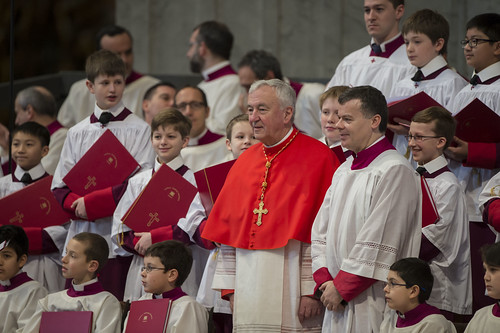26th February 2014
The Consistory: Global and Local

If anyone doubts the global nature of the Roman Catholic Church, they had only to attend the Consistory on 22 and 23 February, when Pope Francis created 19 new Cardinals from the senior bishops around the world. The 16 ‘working’ Cardinals in Pope Francis’s first list now take their part amongst the 120 or so Cardinal-electors in the Sacred College of Cardinals, which represents the principal body of senior advisors for the Pope and the Holy See.
Amongst the new Cardinals were the first ever from Burkina Faso and Haiti, both known for their work with the poor. Archbishops from Korea and the Philippines represented Asia. The Archbishop of Abidjan in Ivory Coast also received a red hat, as did senior Churchmen from Santiago in Chile, Rio de Janeiro in Brazil, Buenos Aires in Argentina and Managua in Nicaragua. Germany, Italy and England provided the European contingent. The Archbishop of Quebec represented North America.
Their supporters from all around the world filled St Peter’s Basilica. It was a truly international occasion, even down to the liturgy: I recall that on 23 February the prayers of the faithful were in Korean, Chinese, Portuguese, French and Indonesian.
It was also a very English occasion (I use the word advisedly, as the English and Welsh bishops’ conference on the one side, and the Scottish on the other, have been separate since the re-establishment of the Catholic Church hierarchies in the United Kingdom in the 19th century). At the Mass in St Peter’s on 23 February there were two English cardinals in the Basilica, the newly created Cardinal Nichols, Archbishop of Westminster, and his predecessor as Archbishop, Cardinal Cormac Murphy-O’Connor, the first time there have been two living English Cardinals since Manning and Newman in the late 19th century.
The Sistine Chapel Choir, the Pope’s Choir, was joined in the Basilica by the Westminster Cathedral Choir, and the Psalm was sung beautifully in English (by a Westminster chorister) possibly for the first time since the Beatification of 85 English martyrs in 1988. The servers, young priests in training chosen to assist the principal celebrant in the service, were provided by the English seminary in Rome, the Venerable English College.
It was an event that therefore managed to encapsulate the uniquely global and simultaneously local identity of the Catholic Church, and the Holy See. On the one hand, the universal Church, with over 400,000 priests and 5,000 bishops around the world, led by an Argentinean Pope. On the other, a strong local presence, with each national Church celebrating its own traditions, perspectives, history and language under the overarching Catholic roof. There will always be tensions between global and local, but that rich combination of identities remains a particular strength for the Holy See. As the Catholic Church grows beyond its traditional base, that reality is only likely to become more complex in the years ahead.